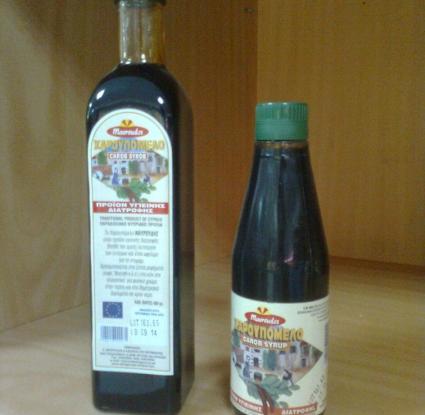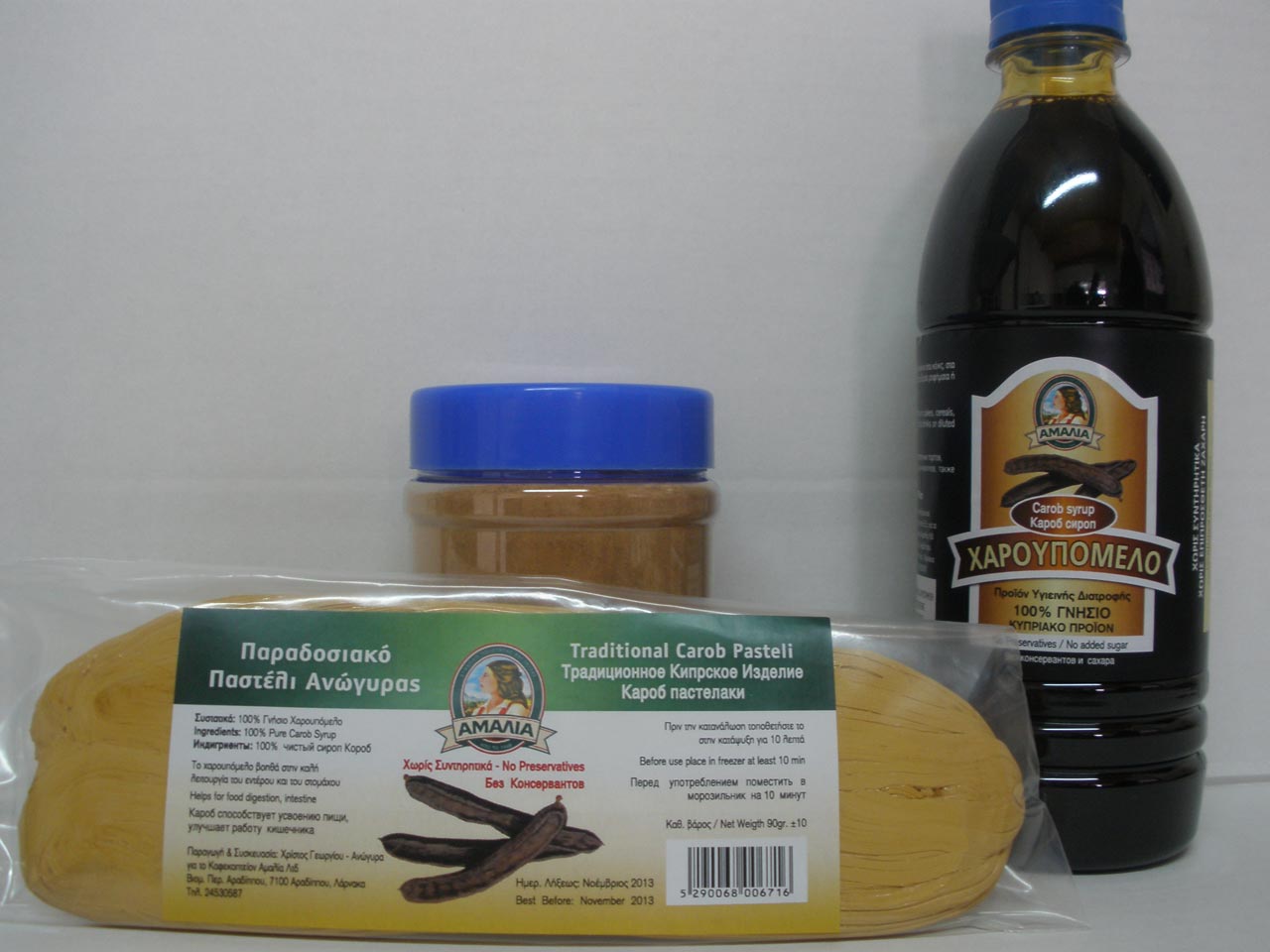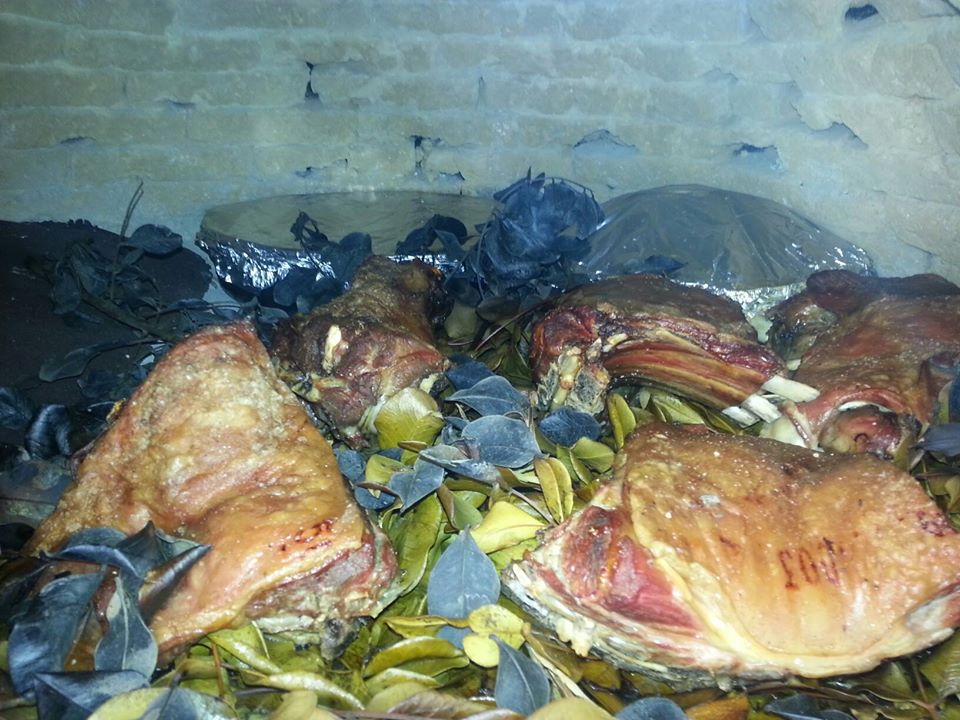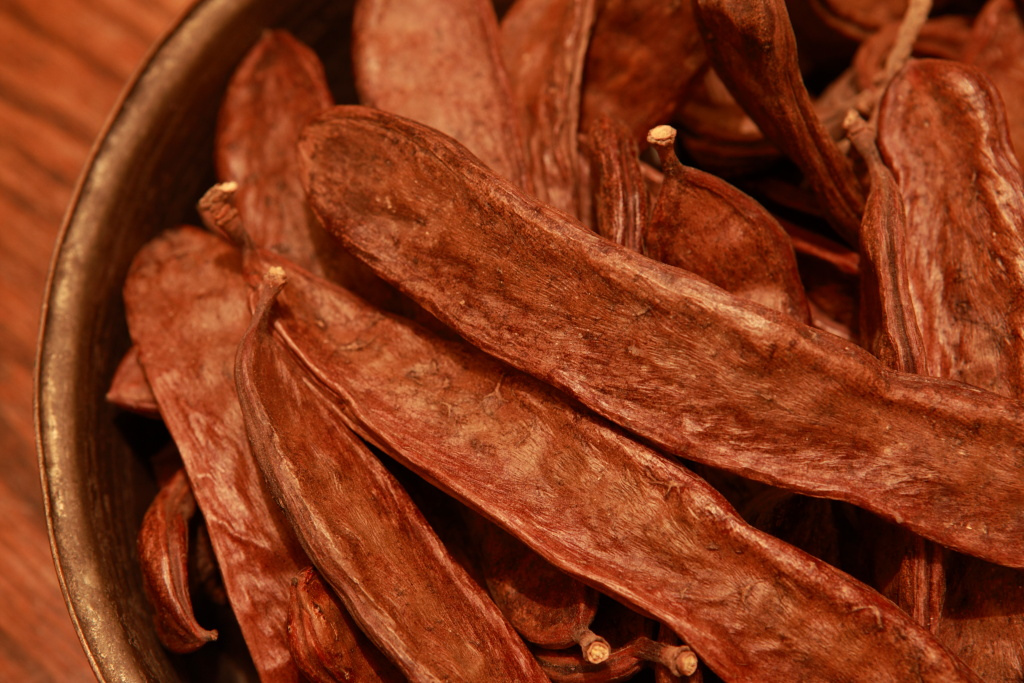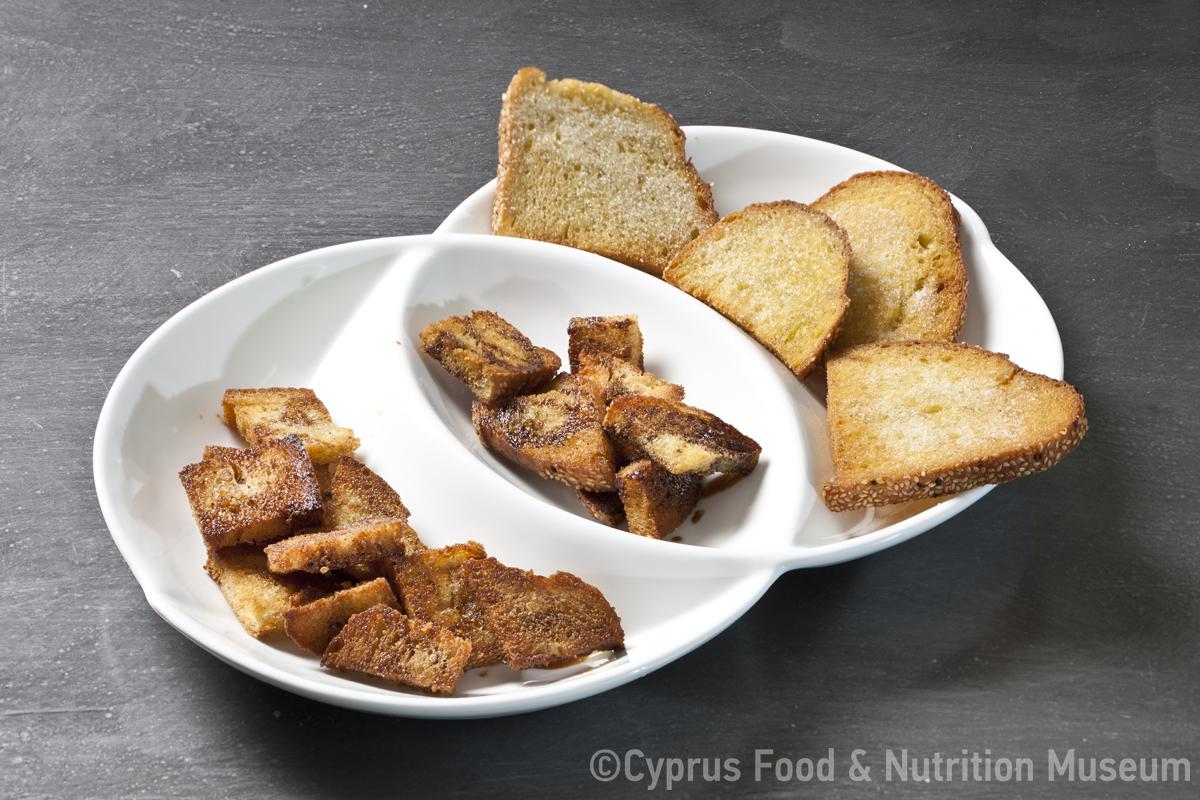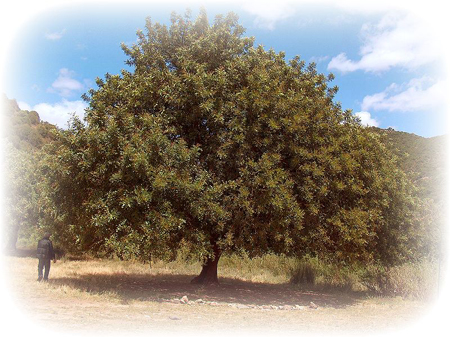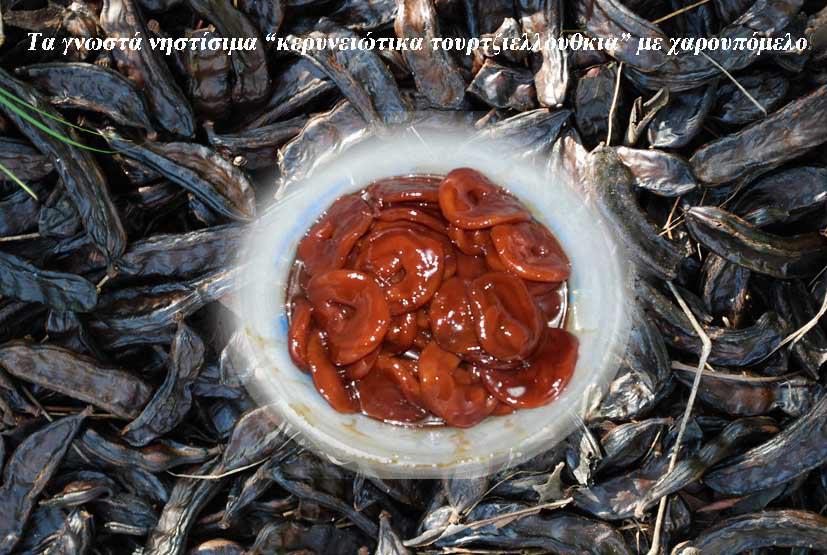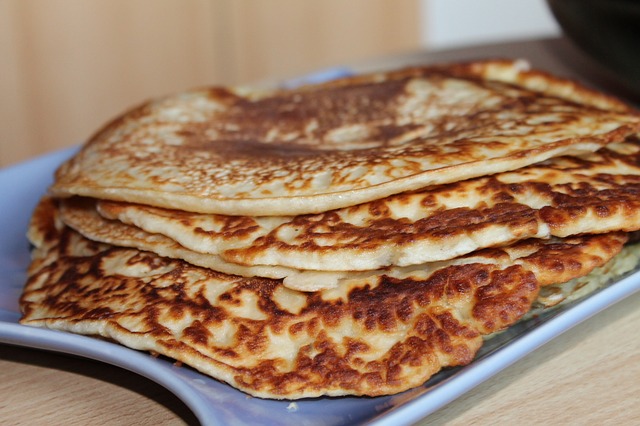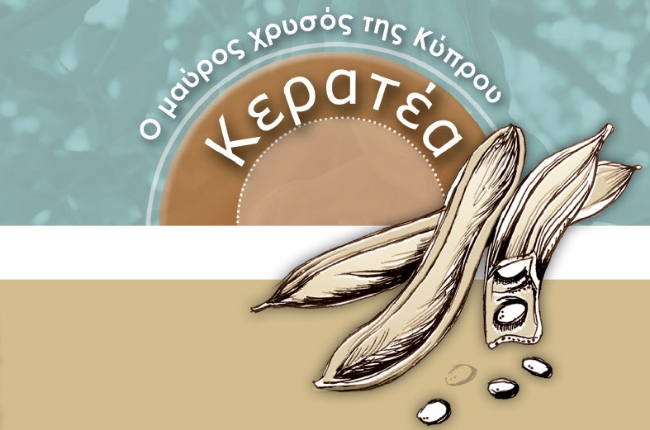People used to spread it on bread with tahini, especially on fasting days, or to prepare tertz̆ellouthkia (a type of pasta with carob syrup).
Name - Origin
Χαρουπόμελο.
ETYM. < teratsin (carob) + melon (honey) (Yangoullis 2009, entry τερατσόμελον,το, 466)
Scientific name of carob: Ceratonia silicual L
The process of producing carob syrup as described by a resident of Kythrea (village in the Nicosia district, occupied by the Turks) started with the selection of fine and large carobs and their rinsing in baskets. This was followed by pounding them with a stone and soaking them in water for 3-4 days. Then, the carob juice would be boiled in a hartzin (cauldron) until thick. Women used to store carob syrup in glass or clay containers (Petasi 1992).
In the village of Anogyra, in the Limassol district, the process of carob production differed. During the harvesting period, the women would choose large carobs with a lot of juice. They would then wash and grind the carobs in the mill and put them in a basket for 20-24 hours, where they would periodically moisten them with water. They would place the basket in a way that the juice dripping from the carobs would be collected in a hartzin (cauldron). This juice was called s̆erepéttin. Housewives would boil the s̆erepéttin over a low fire and stir it for 7 hours until it thickened (Apostolidou-Orphanidou 1991). Archimandrite Leontios Hadjikostas gives us the following information about the production of carob syrup in the village of Kazafani in the Kyrenia district, during the interwar period: “Out of one kantari (180 okas) of carobs they used to get 90 okas of thick carob syrup. In villages, thinner syrup was customary for everyday use and the yield per kantari could reach 120 or even 130 okas of syrup” (Hadjikostas 1994, 113).
Functional and symbolic role
The use of carob syrup in Cypriot diet was varied. They used to spread it on bread with tahini, especially on fasting days, or to prepare tertz̆ellouthkia (a type of pasta with carob syrup). At other times, housewives would prepare koullourouthkia (cookies) kneaded with flour and water and boiled in carob syrup (Apostolidou-Orfanidou 1991). On days when oil consumption was allowed, carob syrup was added to bulgur pilaf (Hatzikostas 1994, 113). Workers used to drink carob syrup as a refreshing drink, which they would dilute with water and call kiantzj̆ alin. They would drink it during the harvest period in the fields, with pieces of toasted bread as a fulfilling meal (Hadjikostas 1994, 113). Carob juice, called s̆erepettin, was also a refreshing drink (Apostolidou-Orfanidou 1991).
'The best and the most painless medicine for constipation’ (Christodoulides 1999, 64).The use of carob syrup in the Cypriot diet varied. On Lent days, they would dip the bread in it and make cookies with it. Some used to mix it i with tahini, which was very tasty. In the fasting days in which oil consumption was allowed, they would drizzle carob syrup over bulgur pilaf (Hadjikostas L. 1994, p. 113).
On Lent days, they would dip the bread in it and make cookies with it. Some used to mix it i with tahini, which was very tasty. In the fasting days in which oil consumption was allowed, they would drizzle carob syrup over bulgur pilaf (Hadjikostas L. 1994, p. 113).
Loulloutsia or loulloutkia was pasta cooked in carob juice; this pasta was prepared during fasting periods and especially on the feasts of Ai Yianni (St John - 29 August) and Timiou Stavrou (Holy Cross - 14 September) (Samaras 1992).
Additional information and bibliography
Athanasios Sakellarios, a researcher of Cypriot history and author, gives us the following information: ‘The carobs of Cyprus, commonly called teratsia or haroupia, are very sugary and mellow. The best of them are found in Limassol district, in Apessia, Gerasa, Apsiou, Mouttayakka etc. From these they make carob syrup and pastelli. All carobs are exported to Russia, Italy, Austria, France, England, Turkey and Egypt’ (Sakellarios 1991, 245).
In the village of Bellapais (village of Kyrenia district, occupied by Turks) the art of making carob syrup and pastelli has existed since ancient times. As there were thousands of carob trees in the area and it was difficult to sell the product [...] the villagers would produce carob syrup and pastellin and sell it themselves either at fairs or to resellers.At the beginning of our century (20th century) there were three carob mills operating in the village, more or less in the same neighbourhood. The one of Tillyros, the one of Savvas tou Hattinou and the one of Katysiis. That is, more than 20 family men were occupied with the production of carob syrup and pastelli (Christodoulides 1999, 62-63).
In a 1900 manual written by the then Director of the Department of Agriculture, it is stated that 15 okas of carobs produce about 8 okas of carob syrup and about 6 okas of pastelli (Gennadios 1900, 15).
Apostolidou-Orfanidou E. (1991) «Το παστέλλιν της Ανώγυρας», Λαογραφική Κύπρος 21,41, 95-99.
Gennadios P. G. (1914), Λεξικόν φυτολογικόν: Περιλαμβάνον τα ονόματα, την ιθαγένειαν και τον βίον υπερδεκασχιλίων φυτών, εν οις και τα λόγω χρησιμότητος ή κόσμου καλλιεργούμενα, των οποίων περιγράφονται και η ιστορία, η καλλιέργεια, τα προϊόντα και αι νόσοι, Paraskevas Leonis Printing House, Athens.
Yangoullis K. G. (2009), Θησαυρός Κυπριακής Διαλέκτου. Ερμηνευτικό, Ετυμολογικό, Φρασεολογικό και Ονοματολογικό Λεξικό της Μεσαιωνικής και Νεότερης Κυπριακής Διαλέκτου, Βιβλιοθήκη Κυπρίων Λαϊκών Ποιητών, Theopress Publications, Nicosia.
Petasis G. (1992), Η κωμόπολη της Κυθρέας: ιστορική, αρχαιολογική, πολιτιστική και λαογραφική επισκόπηση, Stelios Livadiotis Ltd., Nicosia.
Sakellarios A. (1991) Τα Κυπριακά (1890), τ. Α΄, Εκδόσις Εκατονταετηρίδος, Cultural Foundation of Archbishop Makarios III, Nicosia.
Samaras P. M. (1992) «Παραδοσιακές τροφές από ζυμάρι», Λαογραφική Κύπρος 22,42, 83-86.
Hadjikostas L. (1994) «Η χαρουπιά στο χωριό μου την εποχή του μεσοπολέμου», Λαογραφική Κύπρος 24,44, 105-114.
Christodoulides Chr. (1994), Πέλλα-Πάις, Limassol.
Varvara Yangou, Demetra Demetriou, Savvas Polyviou, Argyro Xenophontos

